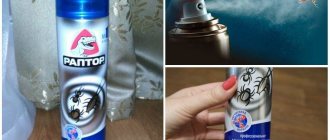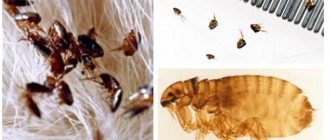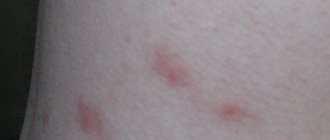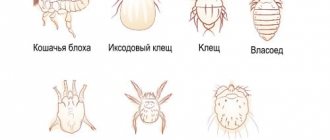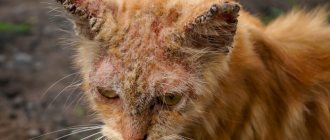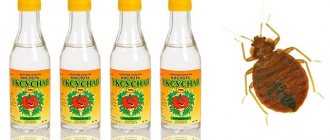In the ranking of the most common parasitic infections in cats, fleas lead by a wide margin. They are found both in pets that walk frequently and in couch potatoes.
In order to avoid the dangerous consequences of a flea infestation, owners must know how to determine that a cat has fleas and what steps to take to quickly remove the annoying bloodsuckers.
Where do fleas come from on cats?
There are many ways cats can become infected with fleas. The presence of parasites does not depend on the type and place of residence of the cat and what kind of care is provided to it. This is primarily due to some characteristics of cat fleas and their life cycle.
There are four stages of flea development:
- egg;
- larva;
- chrysalis;
- adult.
Only females that have drunk blood can reproduce. One clutch is 3-15 eggs. A well-fed flea can lay up to 50 eggs per day, which are not retained on the animal’s fur, but fall off from it in different places, remaining on the carpet, on the floor, on the bed - wherever the infected animal has been. Thus, the eggs quickly spread throughout the room, and then develop, turning over time into a sexually mature individual.
Infection
A cat can become infected with parasites:
- from another animal;
- while walking;
- at home (fleas can get into the house on outdoor shoes or clothes, from the basement, from neighbors).
If a cat previously had fleas, then they were removed, but the apartment was not treated, they will definitely reappear on the pet soon.
Where do fleas come from on a domestic cat?
The most careful care of your pet, even if it does not go outside, is not a 100% guarantee that your pet will not have parasites. People often ask how a domestic cat got fleas if it has never left the premises or interacted with outdoor animals. In fact, the transfer of parasites from one animal to another is just one way of infection. There are several of them:
- walking on land infested with flea eggs;
- contact with an infected animal;
- brought into the house by a person (most often these are insect eggs, but there may also be adults).
Therefore, a pet can easily pick up these ubiquitous parasites. If your pet walks outside, then the probability of infection is almost 100%.
Up to 200 insects can live on one animal at the same time.
Why are they dangerous?
The consequences of flea infestation in cats appear quite quickly. The presence of parasites negatively affects the pet’s appearance, emotional state, and health:
- severe itching appears;
- the condition of the skin and fur worsens (the cat scratches the bites, wounds appear on the skin, and the hair falls out in places);
- due to flea saliva entering the blood, allergic dermatitis develops;
- helminthiasis;
- infectious diseases appear;
- cats can develop anemia from numerous flea bites;
- Due to constant discomfort, appetite deteriorates, sleep deteriorates, behavior changes - the pet is restless and lethargic.
Fleas do not live on people, but they can attack (if there is no other victim nearby); for the cat owner, it is not so much the insect bites themselves that are dangerous, but their consequences:
- skin irritation, itching, dermatitis;
- allergy;
- worms (in case of accidental ingestion of a flea).
In addition, parasites transmit pathogens of serious diseases, such as anthrax, hepatitis, typhoid and plague.
How to tell if a cat has fleas
How to determine if a cat has fleas? This is one of the most frequently asked questions on this topic. It is quite simple to identify parasites on an animal’s body; there are characteristic signs of this disease that are hard to miss:
- The pet not only itches, but violently bites into the fur, which it does especially often.
- The animal is restless and very nervous. Insects cause severe itching, depriving them of their usual rest. Often meows pitifully, trying to attract your attention.
- When scratching, you can see brown lumps - these are parasite excrement.
- Also, when combing, the parasites themselves are visible.
The disease is conventionally divided into several stages. Immediately after infection (the first stage), the animal’s behavior is not much different from usual - the cat eats normally and is playful. Visually detecting parasites is almost impossible because there are very few of them.
The only symptom that may indicate that pest infestation has occurred is your pet's frequent scratching.
At the second stage of infection, the animal’s behavior changes greatly: it begins to get nervous, sleeps poorly, constantly itches and tries to gnaw out pests with its teeth. Scratches and wounds appear on the body. At this stage, parasites can be easily detected visually.
If measures are not taken immediately, the disease will progress. Your affectionate, sociable and cheerful cat will turn into a gloomy and downtrodden animal. In addition, infection in an advanced stage has unpleasant health consequences:
- the animal loses weight and becomes weaker;
- stops playing;
- the fur falls out in clumps;
- Frequent vomiting may begin;
- various dermatitis develops.
It can be added that in caring owners, the infection does not reach the third stage. It is difficult not to notice parasites already at the second stage of the disease, and the means that exist now (this will be discussed in detail below) allow you to effectively and fairly quickly get rid of these insects.
The most favorite places for fleas to live on a cat’s body are the stomach, neck area and the jaw area. It should be remembered that they are not the only parasites that can appear on your pet. There are also lice eaters, but they are usually located on the fur, and fleas prefer the skin of the animal.
Symptoms of flea infestation
You can find out whether a cat has fleas almost immediately after the insects appear. The very first symptom is that the animal begins to itch more often, and does so suddenly and very vigorously. Over time, other signs of infection appear:
- the fur becomes dull and falls out in places;
- from constant scratching due to flea bites, abrasions and sores appear on the cat’s skin;
- flea excrement is found on the cat’s skin, which looks like small dark crumbs;
- the animal sleeps poorly, eats less, worries, and meows often.
Flea cat
It is easy to check for the presence of fleas - just part the fur and carefully examine the skin; with a severe infestation, you can notice not only scratching and traces of vital activity, but also crawling insects.
Recognizing the enemy by sight: what a flea looks like
The most common type of flea that plagues furries is the cat flea, Ctenocephalides felis. A female flea with eggs can reach a length of up to one and a half centimeters, but usually fleas are very small insects (2-3 mm) of a dark color with flattened sides.
This body shape allows them to be less vulnerable: it is almost impossible to crush a flea with your fingertips, but only by squeezing it between the nail plates.
Because of this cunning form, which relieves fleas of the fear of being caught, nature has not provided “camouflage” for their bites: they do not have an anesthetic secretion, like other parasites, and flea bites are really very painful. When they bite, they feed and suck blood.
Treatment and prevention of fleas in cats
There are two main types of parasite treatments:
- medicinal - contains insecticides that kill insects;
- repellents – contain substances that repel fleas.
They come in different forms, so you can choose the product that is easy to use and best suited for your specific pet.
Collars
A collar is an excellent means of preventing insects. It emits a specific aroma that bloodsuckers cannot tolerate and therefore do not even approach the cat, much less settle on it. It is more difficult to kill fleas with its help, although some manufacturers produce collars impregnated with insecticides. Collars only affect adults and have no effect on eggs or larvae.
Drops
When deciding how to remove fleas from a cat, most cat owners choose drops. This is a simple and effective remedy that helps destroy parasites living on a cat and prevent re-infection. The solution is applied to the skin in the withers area so that the pet cannot lick it off. Active substances are absorbed into the bloodstream and distributed over the surface of the body, exerting a contact and systemic effect on insects. Drops from various manufacturers are valid from 4 weeks to 2-3 months.
Shampoos
Flea shampoos are in great demand, primarily due to the fact that they are the most gentle and effective product available. They can remove fleas even from kittens and pregnant cats. Shampoos come in liquid and dry types. They begin to act immediately after application, but unlike drops, the preventive effect does not last long. For this reason, shampoos are often combined with other products, such as a collar.
Sprays
Sprays are another effective way to kill fleas on cats. The product is sprayed, making sure that the solution gets on the animal’s skin. For this reason, aerosols are more often used to treat short-haired breeds, since in pets with long, thick hair, the drug may remain on it, which means the desired effect will not be achieved.
Shampoo application
Sprays are quite toxic, therefore they have contraindications for use, and during the procedure, precautions must be taken. Sprays can be used not only to treat pets, but also to disinfect premises.
Pills
Tablets are used when external remedies cannot be used for some reason (for example, the cat’s skin is severely damaged) or if the case is advanced and the tried drugs have not yielded results. After ingestion, the active substance is absorbed into the blood and the animal dies after being bitten.
There are a number of contraindications for taking the tablets, and only a veterinarian can prescribe them.
Vaccination
Vaccination is a fairly new method of preventing flea infestation. It is recognized as quite aggressive, and experts warn about possible adverse reactions. The advantages of vaccination are effectiveness and prolonged action. One vaccination is enough to forget about parasites for a year. The doctor should choose the drug and vaccinate it after examining the animal.
Fleas. Symptoms Diagnosis and treatment. Choice of drugs.
Fleas are the most common cause of itching in cats and dogs.
Adult fleas attack animals and, less commonly, people. Flea attacks do not necessarily manifest themselves in a noticeable way. Cats, for example, do not scratch as much as they lick themselves. For example, owners often notice that the animal, upon returning from the dacha, begins to wash itself more often. Flea bites lead to a variety of problems - bald spots, weeping ulcers, scratching, scabs, etc. These are common signs of flea bites.
Fleas lay eggs in animal fur. But unlike nits (lice eggs), they fall down after drying. After some time, the larvae hatch from them.
Flea larvae live well in carpets, chair upholstery, and animal bedding and readily feed on any organic matter. They will be satisfied with even ordinary detritus - exfoliating skin cells, in other words - “dandruff”. As well as feces of adult fleas that fall from the animal’s fur. Flea larvae often eat egg packets that are secreted by cucumber tapeworm segments. Thus, your pet may later be infected with helminths. In the absence of such “feeding,” the larvae quite easily manage with cannibalism and eat each other. Those. even in an empty basement, where a stray cat goes to relieve itself once every five years, a whole horde of flea larvae can live. The larvae transform into a pupa and after some time become adults. In addition, when the basement becomes completely unbearable, adult parasites will gladly visit the apartments located above. It is a mistake to believe that if a cat does not go outside, it cannot have fleas. It is also a mistake to assume that your dog or cat does not have fleas if you do not see them. Since fleas run very quickly, it is often not possible to detect them on an animal. Therefore, many people simply examine the animal and believe that it does not have fleas.
In some cases, fleas can be detected thanks to their excrement (feces), which consists of undigested blood residues. They look like comma-shaped brown crumbs.
The white paper test is based on the detection of excrement. The animal is placed on a sheet of white paper or a light table. Carefully comb or shake out the fur. Everything that has spilled onto the table or sheet is carefully inspected and smeared (the debris is swept from the table onto a white sheet) using a wet finger (or the sheet is pre-wetted). Flea feces leave a rusty-red mark because... contain hemoglobin.
The most reliable protection against fleas is preventive treatment of all animals in the apartment with flea drops on the withers (for cats - cat drops, for dogs - dog drops).
If it turns out that you did not pay enough attention to prevention, and your animal already has fleas, flea treatment should include two stages:
1. Destruction of adult fleas on an animal.
2. Destruction of eggs, larvae, pupae and young fleas indoors.
The first stage is actually the simplest. Most modern drugs easily kill most fleas on animals within the first hours after application. The remaining fleas will die in the first two to three days. If you find single fleas after this, this often indicates that there are a fair number of them in the room, and they are attacking the animal. These fleas will also die if your product is reliable. Modern drugs usually work within 30 days after application, plus or minus a week.
The choice of drug depends on the age of the animal and your financial capabilities. Our recommendations are:
1. Try not to give cats drops and shampoos containing permethrin - this substance is highly toxic for cats, and most cheap products with it do not understand how to dose it, and as a result, the animal may receive too large a dose.
2. Avoid putting flea collars on cats.
She can hang herself with it on the nearest nail, fence, pole, branch. Wearing a collar for a long time in most cats leads to rubbing of the fur on the neck. When petting a cat, as a rule, they scratch it behind the ear, chest, neck; moreover, the animal will place the collar under your hand and also rub it against you. The doses of the substance will be miniscule and safe, but completely unnecessary for you.
3. Do not rely on extra long lasting collars (3-6 months) for protection against ticks or for animals allergic to flea saliva. In these cases, it is better to use drugs that last for about a month - this makes it easier to control the treatment.
4. Do not rely on flea shampoos: they are difficult to dose, cats have a hard time with bathing, and when washed, the fatty layer is washed off from the surface of the skin, so even if insectoacaricidal drops are applied to a washed animal, they will not spread and will not act soon. In addition, after you wash off the shampoo from the animal, it ceases to protect it and re-infection occurs.
A few more NO's:
1. Do not use household aerosols against insects (cockroaches, mosquitoes, etc.) to rid an animal of fleas
2. Do not use gardening insect repellents to treat apartments and animals.
3. Drugs used to treat humans cannot always be used on animals. So, most of them contain permethrins, which are safe for people, but dangerous for cats. Most of them are used only for application to clothing, and not to open skin.
4. Chlorophos, DDT dust, diclofos - do not use on animals or in the house. Get rid of their stock.
Treating the premises against flea eggs, pupae and larvae
Man's best friend and fleas' worst enemy is a vacuum cleaner. A vacuum cleaner gets rid of flea eggs and pupae by simply removing these little animals. Naturally, the dust collection container must be cleaned immediately after cleaning.
An excellent method in winter is to clean outside. It would be suitable to either turn the pile of carpet over into the snow, followed by knocking it out and trampling it, or simply knock the dust out of it in the cold. It also works well to simply move carpets and rugs onto the balcony in the cold.
Rooms where it is impossible to use a vacuum cleaner can be treated with “butox”, “neostomazan”, etc. Dilute according to the instructions and spray the room. The smell of these products is unpleasant. Keep children and animals away until surfaces are completely dry.
What to do if the fleas could not be removed?
In rare cases, the measures taken turn out to be useless and it is not possible to get rid of fleas. The first step is to check whether the chosen drug was used correctly and whether it is expired. You can try another product or combination, such as shampoo and a collar. Perhaps the fleas remained in the house and simply returned to the animal. To avoid this, it is necessary to disinfest the premises.
If, after all the measures taken, the cat still suffers from fleas, the best solution is to go to a veterinary clinic, where the doctor will select an effective treatment.
How to treat a pregnant or lactating cat and kitten?
Pregnant cats must be treated for fleas, as parasites not only worsen the cat’s condition, but also negatively affect the development of the offspring. If newborn kittens are exposed to a massive flea attack, they may even die from an infection that their fragile immune system cannot cope with, or from anemia.
Some manufacturers produce preparations that contain low-toxic insecticides and are suitable for treating pregnant and lactating animals. Before using the product, you should consult your veterinarian. If there are few fleas, you can resort to folk recipes, for example, essential oils.
Kittens up to one and a half months old are relieved of parasites by combing, bathing in salt water or with tar soap. Starting from 6 weeks, you can start using pharmaceutical drugs that are approved for this age. And from 3 months, kittens are treated with the same means as adult cats, observing the dosage.
Home disinfection
Ridding your domestic cat of fleas is not enough. After all, insects, their eggs and larvae probably remained in the house, and very soon the pet will be re-infected. To avoid this, it is necessary to treat the room simultaneously with the treatment of the animal.
spring-cleaning
The first step is to carry out general cleaning:
- wash curtains, bedspreads, decorative throws on furniture, pillowcases from sofa cushions, cat litter (it is advisable to wash at temperatures above 60⁰C and then iron);
- wash street shoes, have street clothes cleaned;
- get rid of dust.
Then the room is sprayed with an insecticidal spray, paying special attention to the floor, cracks and baseboards, not forgetting upholstered furniture. There should be no people or animals in the room during the process. After treatment, you must leave the room for the time specified in the instructions, and upon returning, ventilate for several hours.
After this, thoroughly wash the floors, wipe the surface of the furniture, window sills (you can add a couple of drops of essential oils to the water), vacuum up the upholstered furniture and carpeting.
